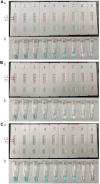Development and Clinical Validation of Multiple Cross Displacement Amplification Combined With Nanoparticles-Based Biosensor for Detection of Mycobacterium tuberculosis: Preliminary Results
- PMID: 31572340
- PMCID: PMC6753184
- DOI: 10.3389/fmicb.2019.02135
Development and Clinical Validation of Multiple Cross Displacement Amplification Combined With Nanoparticles-Based Biosensor for Detection of Mycobacterium tuberculosis: Preliminary Results
Abstract
Tuberculosis is still a major threat to global public health. Here, a novel diagnosis assay, termed as multiple cross displacement amplification combined with nanoparticle-based lateral flow biosensor (MCDA-LFB), was developed to simultaneously detect IS6110 and IS1081 of Mycobacterium tuberculosis (MTB) in DNA extracted from reference strain H37Rv and clinical samples. The amplification can be finished within 30 min at a fixed temperature (67°C), thus the whole procedure, including rapid template preparation (15 min), isothermal reaction (30 min) and result reporting (2 min), can be completed within 50 min. The limit of detection of multiplex MCDA assay was 10 fg per reaction. By using the multiplex MCDA protocol, cross-reaction with non-mycobacteria and non-tuberculous mycobacteria (NTM) strains was not observed. Among clinically diagnosed TB patients, the sensitivity of liquid culture, Xpert MTB/RIF and multiplex MCDA assay was 42.0% (50/119), 49.6% (59/119), and 88.2% (105/119), respectively. Among culture positive samples, the sensitivity of Xpert MTB/RIF and multiplex MCDA assay was 86.0% (43/50) and 98.0% (49/50), respectively. Among culture negative samples, the sensitivity of Xpert MTB/RIF and multiplex MCDA assay was 23.2% (16/69) and 81.2% (56/69), respectively. The specificity was 100% (60/60) for Xpert MTB/RIF and 98.3% (59/60) for multiplex MCDA. Therefore, the multiplex MCDA assay for MTB detection is rapid, sensitive and easy to use and may be a promising test for early diagnosis of TB.
Keywords: MCDA-LFB; Mycobacterium tuberculosis; lateral flow biosensor; limit of detection; multiple cross displacement amplification.
Copyright © 2019 Jiao, Wang, Wang, Wang, Xiao, Sun, Li, Wen, Zhang, Ma, Huang and Shen.
Figures





Similar articles
-
Two target genes based multiple cross displacement amplification combined with a lateral flow biosensor for the detection of Mycobacterium tuberculosis complex.BMC Microbiol. 2021 Oct 4;21(1):267. doi: 10.1186/s12866-021-02328-6. BMC Microbiol. 2021. PMID: 34607556 Free PMC article.
-
A diagnostic test that uses isothermal amplification and lateral flow detection sdaA can detect tuberculosis in 60 min.J Appl Microbiol. 2021 Jun;130(6):2102-2110. doi: 10.1111/jam.14902. Epub 2020 Nov 12. J Appl Microbiol. 2021. PMID: 33070404
-
Development and Preliminary Application of Multiplex Loop-Mediated Isothermal Amplification Coupled With Lateral Flow Biosensor for Detection of Mycobacterium tuberculosis Complex.Front Cell Infect Microbiol. 2021 Apr 27;11:666492. doi: 10.3389/fcimb.2021.666492. eCollection 2021. Front Cell Infect Microbiol. 2021. PMID: 33987108 Free PMC article.
-
Lateral flow biosensor combined with loop-mediated isothermal amplification for simple, rapid, sensitive, and reliable detection of Brucella spp.Infect Drug Resist. 2019 Jul 30;12:2343-2353. doi: 10.2147/IDR.S211644. eCollection 2019. Infect Drug Resist. 2019. PMID: 31440069 Free PMC article. Review.
-
Loop-Mediated Isothermal Amplification Coupled With Nanoparticle-Based Lateral Biosensor for Rapid, Sensitive, and Specific Detection of Bordetella pertussis.Front Bioeng Biotechnol. 2022 Feb 8;9:797957. doi: 10.3389/fbioe.2021.797957. eCollection 2021. Front Bioeng Biotechnol. 2022. PMID: 35211469 Free PMC article. Review.
Cited by
-
Multiple Cross Displacement Amplification Combined With Real-Time Polymerase Chain Reaction Platform: A Rapid, Sensitive Method to Detect Mycobacterium tuberculosis.Front Microbiol. 2021 Dec 23;12:812690. doi: 10.3389/fmicb.2021.812690. eCollection 2021. Front Microbiol. 2021. PMID: 35003045 Free PMC article.
-
Development and clinical evaluation of a real-time multiple cross displacement amplification assay for rapid and sensitive detection of Mycobacterium tuberculosis.Heliyon. 2024 May 24;10(11):e31901. doi: 10.1016/j.heliyon.2024.e31901. eCollection 2024 Jun 15. Heliyon. 2024. PMID: 38845879 Free PMC article.
-
The rapid and visual detection of methicillin-susceptible and methicillin-resistant Staphylococcus aureus using multiplex loop-mediated isothermal amplification linked to a nanoparticle-based lateral flow biosensor.Antimicrob Resist Infect Control. 2020 Jul 17;9(1):111. doi: 10.1186/s13756-020-00774-x. Antimicrob Resist Infect Control. 2020. PMID: 32680560 Free PMC article.
-
Multiple Cross Displacement Amplification Coupled with Lateral Flow Biosensor (MCDA-LFB) for rapid detection of Legionella pneumophila.BMC Microbiol. 2022 Jan 8;22(1):20. doi: 10.1186/s12866-021-02363-3. BMC Microbiol. 2022. PMID: 34996350 Free PMC article.
-
Rapid and Visual Detection of SARS-CoV-2 Using Multiplex Reverse Transcription Loop-Mediated Isothermal Amplification Linked With Gold Nanoparticle-Based Lateral Flow Biosensor.Front Cell Infect Microbiol. 2021 Jul 14;11:581239. doi: 10.3389/fcimb.2021.581239. eCollection 2021. Front Cell Infect Microbiol. 2021. PMID: 34336708 Free PMC article.
References
-
- Chakravorty S., Simmons A. M., Rowneki M., Parmar H., Cao Y., Ryan J., et al. (2017). The new xpert MTB/RIF ultra: improving detection of mycobacterium tuberculosis and resistance to rifampin in an assay suitable for point-of-care testing. mBio 8 e812–e817. 10.1128/mBio.00812-17 - DOI - PMC - PubMed
-
- Cronin W. A., Golub J. E., Magder L. S., Baruch N. G., Lathan M. J., Mukasa L. N., et al. (2001). Epidemiologic usefulness of spoligotyping for secondary typing of Mycobacterium tuberculosis isolates with low copy numbers of IS6110. J. Clin. Microbiol. 39 3709–3711. 10.1128/JCM.39.10.3709-3711.2001 - DOI - PMC - PubMed
-
- Dorman S. E., Schumacher S. G., Alland D., Nabeta P., Armstrong D. T., King B., et al. (2018). Xpert MTB/RIF Ultra for detection of Mycobacterium tuberculosis and rifampicin resistance: a prospective multicentre diagnostic accuracy study. Lancet Infect. Dis. 18 76–84. 10.1016/S1473-3099(17)30691-6 - DOI - PMC - PubMed
LinkOut - more resources
Full Text Sources

